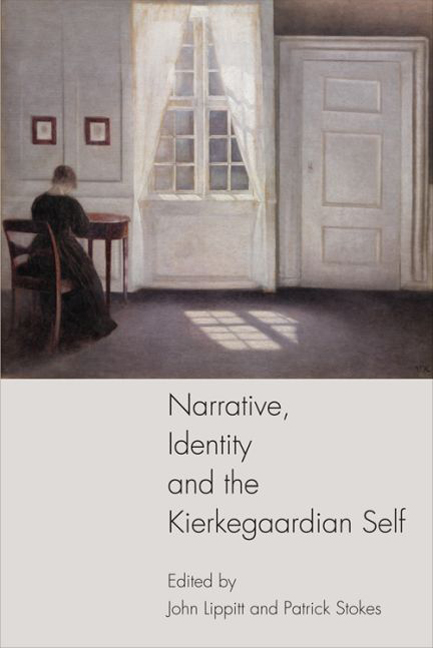Book contents
- Frontmatter
- Contents
- Acknowledgements
- Abbreviations
- Contributors
- Introduction
- 1 The Moments of a Life: On Some Similarities between Life and Literature
- 2 Teleology, Narrative and Death
- 3 Kierkegaard's Platonic Teleology
- 4 Narrative Holism and the Moment
- 5 Kierkegaard's Erotic Reduction and the Problem of Founding the Self
- 6 Narrativity and Normativity
- 7 The End in the Beginning: Eschatology in Kierkegaard's Literary Criticism
- 8 Forgiveness and the Rat Man: Kierkegaard, ‘Narrative Unity’ and ‘Wholeheartedness’ Revisited
- 9 The Virtues of Ambivalence: Wholeheartedness as Existential Telos and the Unwillable Completion of Narravives
- 10 Non-Narrative Protestant Goods: Protestant Ethics and Kierkegaardian Selfhood
- 11 Narrativity, Aspect and Selfhood
- 12 The Senses of an Ending
- 13 The End? Kierkegaard's Death and its Implications for Telling his Story
- Bibliography
- Index
6 - Narrativity and Normativity
Published online by Cambridge University Press: 15 September 2017
- Frontmatter
- Contents
- Acknowledgements
- Abbreviations
- Contributors
- Introduction
- 1 The Moments of a Life: On Some Similarities between Life and Literature
- 2 Teleology, Narrative and Death
- 3 Kierkegaard's Platonic Teleology
- 4 Narrative Holism and the Moment
- 5 Kierkegaard's Erotic Reduction and the Problem of Founding the Self
- 6 Narrativity and Normativity
- 7 The End in the Beginning: Eschatology in Kierkegaard's Literary Criticism
- 8 Forgiveness and the Rat Man: Kierkegaard, ‘Narrative Unity’ and ‘Wholeheartedness’ Revisited
- 9 The Virtues of Ambivalence: Wholeheartedness as Existential Telos and the Unwillable Completion of Narravives
- 10 Non-Narrative Protestant Goods: Protestant Ethics and Kierkegaardian Selfhood
- 11 Narrativity, Aspect and Selfhood
- 12 The Senses of an Ending
- 13 The End? Kierkegaard's Death and its Implications for Telling his Story
- Bibliography
- Index
Summary
In his afterword to Kierkegaard after MacIntyre, Alasdair MacIntyre identifies two types of aesthetes. First there is the type we can associate with one of the main subjects of Either/Or, the aesthete known as A: an agent on some level aware of, and likely compelled by, the claims of the ethical existence-sphere, but who ultimately manages to avoid them through various devices of self-deception. According to MacIntyre, this ‘aesthete […] is a divided self, on the surface […] unable to move beyond immediacy, but in his unacknowledged secret depths already engaged with the ethical’ (2001: 348). In such cases an aesthete is definitely beholden to the demands of the ethical, and so if he ever chooses it, the transition to this form of life will be a rational one. In other words, the choice will be guided by ethical reasons; the aesthete will acknowledge how ethical considerations appeal to his interests and thereby motivate him to make this choice – rather than some wilful ‘leap of faith’ into the unknown. Elsewhere, however, MacIntyre describes another kind of aesthete. This aesthete's interests are not guided by ethical reasons, and so whatever transition he makes to the ethical cannot be understood rationally. For this agent:
the transition from the aesthetic to the ethical is and can be made only by a criterionless choice. For to be in the aesthetic stage is to have attitudes and beliefs that disable one from evaluating and appreciating those reasons […] So I reiterate the claim that, on Kierkegaard's view, what can be retrospectively understood as rationally justifiable cannot be thus understood prospectively. (2001: 344)
With certain qualifications, then, MacIntyre stands by his original claim that an aesthete could convert to the ethical view without any criteria (i.e., reasons) determining him – the old spectre of criterionless choice once again (2000: 39). My own view is that he is still wrong to draw this conclusion. When we examine Kierkegaard's scattered observations on conversions between existence-spheres, it is clear he does not espouse the kind of leap that MacIntyre has attributed to him. But I do think MacIntyre's example illustrates an important point that is sometimes overlooked by Kierkegaardians: a human being's motivational structure is so designed that it can support good reasons for an aesthetic agent to persist in the aesthetic life.
- Type
- Chapter
- Information
- Narrative, Identity and the Kierkegaardian Self , pp. 95 - 112Publisher: Edinburgh University PressPrint publication year: 2015



